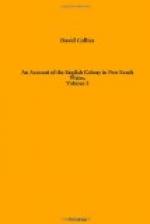Among other reptiles were found the snake with venomous fangs, and some large brown guanoes.
This country is inhabited by men; and, if any judgment could be formed from the number of huts which they met, in about the same proportion as in New South Wales. Their extreme shyness prevented any communication. They never even got sight of them but once, and then at a great distance. They had made fires abreast of where the sloop was at anchor; but as soon as the boat approached the shore they ran off into the woods. Their huts, of which seven or eight were frequently found together like a little encampment, were constructed of bark torn in long stripes from some neighbouring tree, after being divided transversely at the bottom, in such breadths as they judge their strength would be able to disengage from its adherence to the wood, and the connecting bark on each side. It is then broken into convenient lengths, and placed, slopingwise, against the elbowing part of some dead branch that has fallen off from the distorted limbs of the gum tree; and a little grass is sometimes thrown over the top. But, after all their labour, they have not ingenuity sufficient to place the slips of bark in such a manner as to preclude the free admission of the rain. It is somewhat strange, that in the latitude of 41 degrees, want should not have sharpened their ideas to the invention of some more convenient habitation, especially since they have been left by nature without the confined dwelling of a hollow tree, or the more agreeable accommodation of a hole under the rock.
The single utensil that was observed lying near their huts was a kind of basket made of long wiry grass, that grows along the shores of the river. The two ends of a large bunch of this grass are tied to the two ends of a smaller bunch; the large one is then spread out to form the basket, while the smaller answers the purpose of a handle. Their apparent use is, to bring shell fish from the mud banks where they are to be collected. The large heaps of mussel shells that were found near each hut proclaimed the mud banks to be a principal source of food. The most scrupulous examination of their fire places discovered nothing, except a few bones of the opossum, a squirrel, and here and there those of a small kangaroo. No remains of fish were even seen.
The mode of taking the opossum seemed to be similar to that practised in New South Wales*, except that it is probable they use a rope in ascending the tree; for once, at the foot of a notched tree, about eight feet of a two inch rope made of grass was found with a knot in it, near which it appeared to have broken.
[* Vide Vol I Appendix II.]




